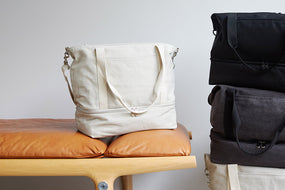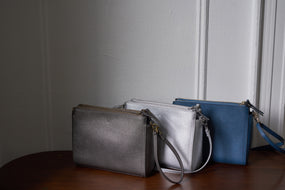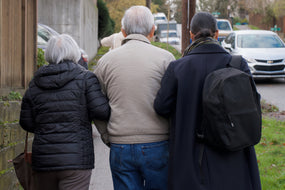As the first bag the Lo family created, the origins of the O.G. were instrumental in setting up the foundation for the Lo & Sons design philosophy: a human-centered design approach. Curious to know about its inspiration, design process, unique shape, and challenges that arose? We sat down with Jan to dig a bit deeper into the birth of the O.G.
Can you tell us about what or who inspired you to design the O.G.?
My mom, Helen, had recently retired and was traveling a lot with our dad, who was a radio astronomer and traveled all across the globe for work. My mom was looking for a bag for herself that fit all her electronics, was lightweight, and did not look overly masculine or tech-y. She couldn’t find one! (She even brought my brother and I to a department store to prove her point).
What specific problems were you looking to solve with this bag?
My mom, like many of us, finds the actual airport experience not that relaxing, particularly going through the security line. Where is my boarding pass? Where is my passport? Is my laptop protected? Will my bag fall off the roller luggage? I'm feeling rushed!
What was the design process like? How many rounds did you go through to reach the current design?
My mom, to her credit, did not stop at only her own personal need. She was curious to know if others also shared this need and if there was a white space in the market. At that time I was living in Beijing, where I had been working for a product design research consultancy (among other things). For US and European companies who were interested in designing products for the China market, we conducted ethnographic research trips to people’s homes, workplaces, and retail spaces. Initially I thought this could be an interesting research project, where I observed people at airports and commuter areas in Hong Kong and NYC. I also interviewed both men and women, who traveled regularly by air for work (e.g., management consultants). Embracing the human-centered design approach, we went through 7 rounds of prototyping with considerable user testing after each round. Below are photos of two earlier rounds of prototypes (left, middle) and the final design (right). A considerable amount of user testing was done between rounds which informed the design of the following bag.

How does the “human-centered design” manifest at Lo & Sons?
The human-centered design approach actually guides not only our product design process, but also how we have designed and built our company. Unlike most family owned businesses, where the older generation creates the company and then passes the knowledge to the younger generation, my mom, my brother, and I all had zero experience making and selling bags. We all had to learn on the fly for everything. Armed with the belief that we/L&S can always improve and evolve, we didn’t feel overwhelmed by not knowing everything at the outset. Looking back, this probably actually became a competitive advantage in that we were not weighed down by “best practices” and conventional thinking. Even looking at our business model, we “prototyped” different approaches. When we went to our first trade show and got 1 order total (for consignment), while at the same time seeing sales grow robustly on our website, we were quick to evolve towards what is now called a D2C model and focusing on e-commerce. Taking the lead from our mom’s personal values, we try to emphasize empathy as a core value in our company culture. This dovetails with the human-centered design approach, which focuses on the people who might use the product, not just only what the designer wants or thinks people should want or need. In a very early prototype of the O.G, the side shoe pocket was originally placed on the left hand side but we found this difficult to access. After more user testing, we moved the pocket to the middle of the side gusset.
The shape of the O.G. is really unique. What’s the reason for this silhouette?
We were working on a tote style, which ultimately became our T.T., and then we were exploring different shapes and construction for a larger bag that could fit shoes. As we were conducting our research, many women, particularly in commuter cities like New York, shared that they often wore flats or sneakers during their commute, and then would change into heels at the office. Or women would go straight from the office to the gym. My brother, Derek, was mocking up different shapes, and when he showed us the rounded shape, my mom immediately gravitated towards that as an elegant alternative to the typical tote construction.
The O.G., like many of our other bags, has a ton of compartments, pockets, and sleeves. What’s the thought process like when you’re considering the number of compartments and the size of each?
We try to empathize and put ourselves in the shoes of the person using the bags. What are the most stressful parts of their day with their bag? What pain points can we try to help minimize? We try to find that sweet spot of just enough pockets and compartments to keep organized, but not too many. I think many of us have had that experience of buying a bag and being super excited about the pockets and functionality, but then after using the bag, you realize some of the pockets were not that functional in practice. We’d like to think and have heard from many of our customers that it’s only after* using a L&S bag like the O.G. that one fully appreciates all the thought and consideration. One earlier prototype includes a water bottle pocket. This was removed after consumer research showed hesitation placing liquid near a laptop. What do you guys think -- should we bring back this pocket?
Any challenges you and the team encountered during the design and production process?
So many challenges! We have concluded that one reason there wasn’t a bag like the O.G. before is that it’s very difficult to make. It was challenging to find a factory who could skillfully produce an intricate bag and expertly work with high-quality materials. We eventually did find a factory, but I also spent 5 months out of each year during the first 2 years at this factory, living by myself in local hotels. My mom and my brother would also come to the factory for weeks at a time. During the first 3 years, I inspected 100% of the bags with help from Derek, meaning he and I have checked literally 1000s and 1000s of zippers, 1000s and 1000s of stitch lines, etc.. Prior to L&S, I had never worked with bags, so I had no idea how many ways things could go wrong when making a bag.
Are there any surprising ways you’ve seen customers use the O.G.?
Some customers have told us they actually used the OG as a diaper bag!
After creating the O.G., what did you learn that you applied towards creating the other bags?
Rapid prototyping with user testing has been very helpful for the design of all of our bags! I also try to remind myself that the first prototype may look nothing like the finalized version, particularly when the first prototype looks, um, rather “rough.” An early lining of the O.G. was recommended by our factory. This was quickly vetoed by Helen, Derek, and me.
Below is a photo of our very first shipment. This was both thrilling and terrifying. At that point, we had no idea if this first shipment would last us 6 months, 1 year, or forever?!









Comments
Destiny
Yes—bring back water bottle pocket!
Virginia Kim
Yes, I’d love a water bottle pocket!!!
Leave a comment